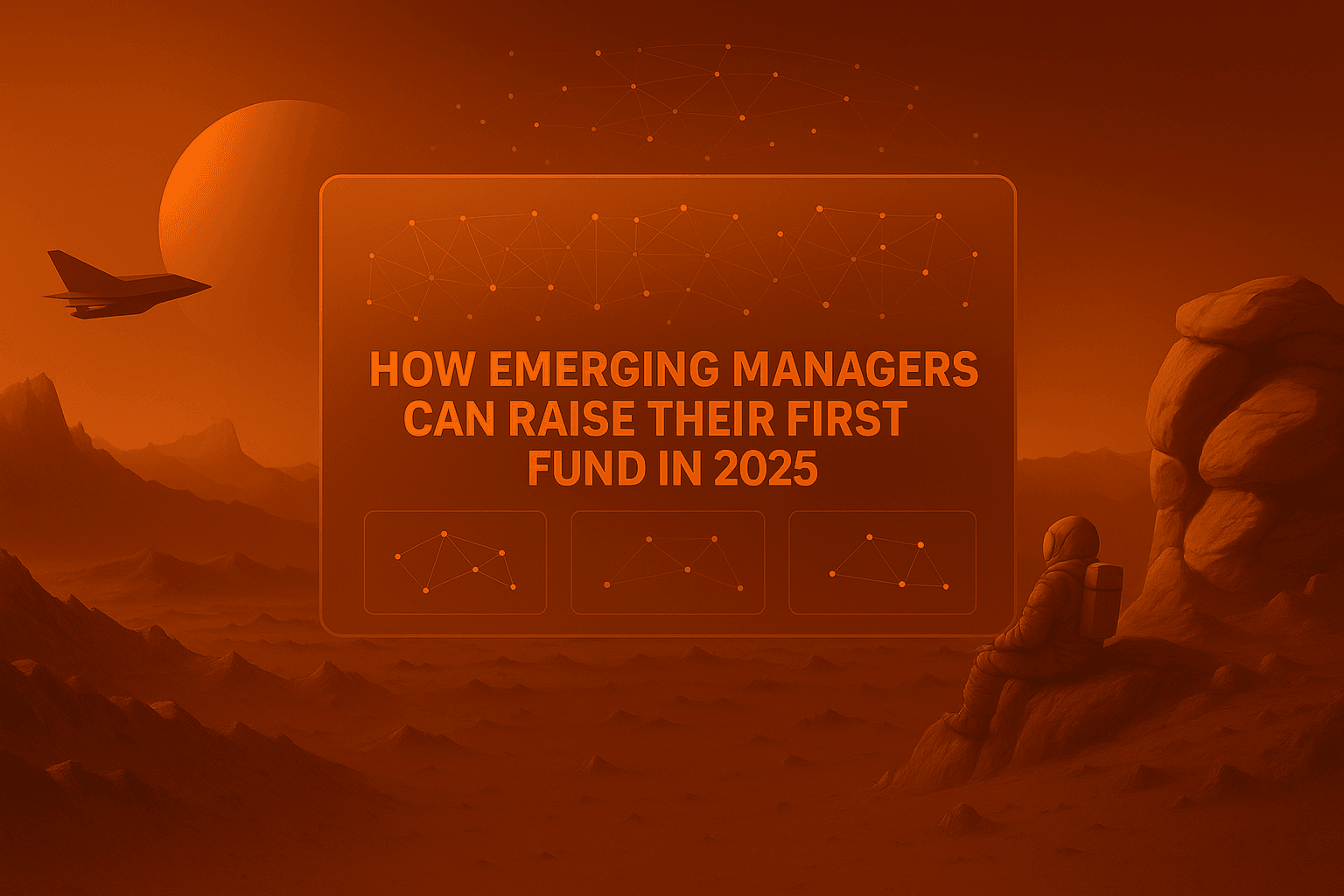A Practical Guide to Fundraising in 2025: Trends, Tools, and Strategy (Alternatives)
What’s changed in 2025 fundraising (family offices, co-invests, secondaries, AI-driven timing) and a step-by-step playbook to convert LP signals into meetings—plus why Altss shortens the path from research to allocation.

A Practical Guide to Fundraising in 2025: Trends, Tools, and Strategy (Alternatives)
A Practical Guide to Fundraising in 2025: Trends, Tools, and Strategy (Alternatives)
Fundraising in alternatives is evolving fast in 2025. Capital is plentiful for the right stories—but LPs are more selective, timelines are longer, and windows open and close quickly. Two realities anchor this market:
- Deal flow ≠ fundraising flow. H1 U.S. startup funding jumped ~76% year-over-year on AI’s surge, while U.S. venture funds raised less capital and took longer to close—median time stretched to ~15 months. Translation: liquidity is reappearing in deals and exits faster than new fund commitments.
- Family offices are tilting liquid, but alternatives remain core. UBS’s 2025 Global Family Office Report shows developed-market equity allocations rising (26% → 29% target) while private-equity weightings edge down modestly near-term amid slower exits—yet alternatives still occupy a large share of portfolios.
Below is the 2025 playbook—what’s changed, what to do, and how Altss compresses the path from research to meetings.
1) Family offices: still decisive—just more explicit about mandate fit
What changed. Single-family offices are leaning into liquid developed markets and “secular growth” (AI, power, resources, longevity) while keeping substantial alternatives exposure. They’re wary of crowded, illiquid corners and want clearer alignment on structure (co-invests, sidecars), fees, and timing.
What to do.
- Pitch themes first, structure second: show how your strategy monetizes a secular driver (policy, demographic, or technology) and the path to liquidity.
- Offer participation options (co-invest/SPV alongside the fund) for concentrated opportunities and fee/term flexibility.
- Align geography and currency with their current tilt (North America/Western Europe overweight in 2025).
Altss angle. Filter by mandate, region, check size, and prior co-invest behavior; route verified decision-maker contacts; and trigger follow-ups when family-office signals change (new filings, event footprints).
2) Mandate intelligence is the timing edge
What to do.
- Maintain a live list of LPs reallocating into your lane (e.g., growth VC, real assets, secondaries).
- Tie outreach to fresh triggers: new mandate statements, policy shifts, or portfolio liquidity events.
- Prioritize LPs whose pacing and vintage program match your close timeline.
Altss angle. Saved searches on strategy + region; OSINT-verified mandate changes; relationship paths for warm routes; deliverability guardrails that keep sequencing clean.
3) Co-investments: build them into the offer, not the appendix
What to do.
- Advertise your co-invest policy up front: governance, timing, and information flow.
- Pre-clear a few co-investable theses (target sectors, size, diligence pack) so LPs can move fast.
- Use prior co-invest history to target likely repeat partners.
Altss angle. Surface LPs with co-invest track records in your sector/region; map who historically partners with whom.
4) Personalization and warm routes still beat cold volume
The reality. LPs scrutinize reputation and digital presence—98% check firm and individual profiles before allocating, and many are reshaping manager rosters while keeping teams lean. Treat outreach like enterprise sales, not mail merge.
What to do.
- Anchor every note in specific overlap (past deals, mandate wording, portfolio gaps).
- Prefer second-degree intros and event follow-ups within 48 hours.
- Ship short, decision-useful content: one-pager with track, edge, pipeline, and timetable.
Altss angle. Relationship graphing to identify connectors; auto-logging of event attendance; scoring that prioritizes high-probability replies.
5) Emerging managers: credible—if you operate like incumbents
Where we are. LP selectivity is elevated and “first-time advantage” has faded; PitchBook notes emerging GPs are no longer closing more funds than experienced peers. The bar has moved to operational excellence: DPI pathways, fee discipline, compliance hygiene, and repeatable sourcing.
What to do.
- Lead with underwriting mechanics (how you originate, decide, and exit), not brand aspiration.
- Prove pipeline momentum (signed LOIs, co-invest demand, referenceable founders/CEOs).
- Offer alignment sweeteners (fee breaks, step-downs, co-invest economics) within ILPA norms.
Altss angle. Show LPs your verified pipeline and demand signals; route references and warm intros efficiently.
6) Where the liquidity is (and how to use it)
Exits & IPOs. U.S. exits improved in Q2 and IPO activity is edging up versus 2024 (with stronger aftermarket in select months), but the market remains selective and episodic. You need a plan for partial realizations and secondary paths—especially if you’re raising while exits are uneven.
Secondaries & continuation solutions. 2025 continues to favor creative liquidity (LP-led and GP-led): useful for recycling DPI into a new vehicle or supporting concentrated winners without forcing premature sales.
What to do.
- Bake secondary options into your data room (continuation-fund logic, price discovery ranges, conflict mitigants).
- Time your close against public windows (earnings cycles, tariff headlines, rate path).
- Keep bridge-to-liquidity scenarios in your LPA and deck.
Altss angle. Monitor exit prints and secondary closes by strategy; alert on LPs leaning into co-invests and secondaries this quarter.
The 2025 fundraising stack (what to implement this month)
Theme proof, not theme prose. Tie your edge to a structural driver and show a realizable liquidity path (secondary, trade sale, or IPO lane).
Signal-led targeting. Keep a live list of LPs that just allocated or published mandates in your strategy—sequence off those signals.
Co-invest readiness. Document terms, process, and “go/no go” criteria; pre-wire a couple of live deals.
Personalization discipline. Reference prior deals, ticket sizes, and pacing in each message; assume your profiles will be reviewed.
Operating hygiene. Short data room, audit-ready track metrics (TVPI/DPI by vintage), compliance calendar, and a quarterly LP update template.
Why Altss—now
- Timing is the edge. Deals are accelerating while fund closes lag; AI-driven concentration magnifies dispersion. You need mandate-level visibility to hit windows.
- Co-invests are mainstream. Most professional LPs now resource co-invest programs—Altss shows who’s active and on what terms.
- Selectivity is real. Emerging managers must show institutional process; Altss compresses diligence by mapping mandates, relationships, and proof-points in one place.
What you get. OSINT-verified investor graph, deliverability guardrails, relationship paths, event signals, and strategy/domicile filters that match your IC. Build the shortlist, launch sequences, book meetings—without drowning in noise.
Related articles

Anchor Investors for Emerging Managers & Startups: The 2025 Playbook
A step‑by‑step playbook for landing an anchor investor (or LP), understanding anchor vs. lead, structuring first closes, and creating momentum in your round.

How Emerging Managers Can Raise Their First Fund in 2025
How emerging managers can raise their first fund in 2025: a precise, step-by-step playbook that covers allocator targeting, pipeline math, ILPA-aligned diligence, OSINT signals, and modern outreach. Written for GPs and IR teams using verified allocator data and real-time LP coverage.